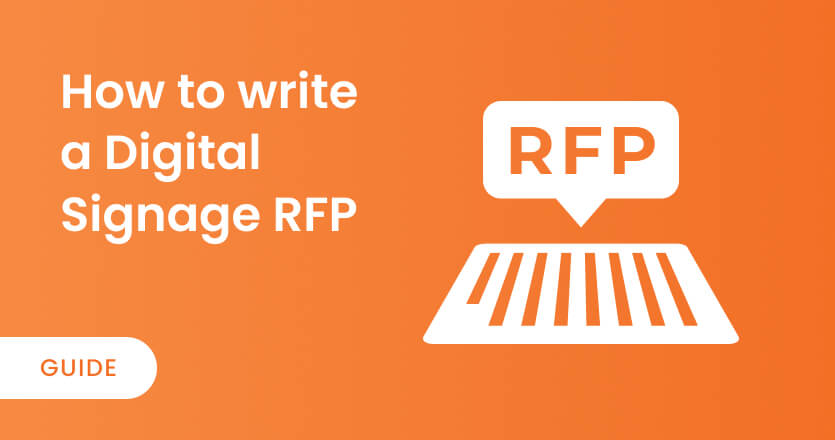Need to put together a request for proposal (RFP) document for a digital signage project, but not sure what to include? We’ve put together the specific information required for a well-written RFP to ensure you find the right vendor for your digital signage needs.
What is an RFP and what is its purpose?
A request for proposal (RFP) is a business document used to solicit bids from potential vendors for a project solution. Ideal for large-scale implementations, the RFP outlines the services required and specifies the evaluation criteria for reviewing bid proposals.
Put out early in the procurement process, a digital signage RFP offers organizations the opportunity to obtain a range of proposals and pricing to review for finding the best possible provider.
What to include in a digital signage RFP
To define what you want in an RFP, set out your vision and what you are seeking to accomplish so that everybody, including various stakeholders, is on the same page. It’s really worthwhile specifying some background information about your company, its core values and purpose.
Likewise, it’s important to describe the aims and objectives of what your company is looking to achieve. This can include information such as what you want to get out of the software, product functionality and setting budget parameters to address pricing and cost expectations.
Of course, doing research to make a shortlist of highly-rated vendors in the industry is essential before drafting an RFP. However, it’s equally beneficial to request business references to make the vendor selection process more effective.
5 key sections for a digital signage RFP
What makes a good RFP? Being concise, including contextual information and asking vendors the right questions help produce high quality bids and get the relationship with your supplier off to the best start.
In order to write an effective digital signage RFP, it’s important to include these essential sections:
Statement of purpose
Start with a statement of purpose outlining the intent behind your project and use case. This covers what your company is searching for in terms of deliverables and performance criteria. State what you want to get done in this contract regarding hardware & software, location factors, timelines and cost.
Scope of the work
What are the specific tasks to perform to meet your project objectives? Have you described the methods required and all departments and stakeholders the bidder will be expected to work directly with? Lay out exactly what you want the vendor to do, detail what the responsibilities are and how you want things set up to lay the foundation for a well-planned project.
Performance standards
Set parameters of performance. Is there a process for upgrades and new releases? How will you be able to test and monitor the solution, or seek support (onsite or remotely) when problems arise? Technical requirements, such as implementation planning, platform maintenance and system administration and security can be addressed here.
List of deliverables
Think of this as a checklist of all the things that you expect to receive. Digital signage deliverables to take into account are device specifications, display monitors, software compatibility and data storage. Other common requirements include CMS platforms, IOS certifications and encrypted cloud-based systems.
Evaluation process
Include details on how you will evaluate responses. Alongside this, it can be helpful to list criteria for benchmarking RFP bids competing for the project. Factors like product/market differentiators, vendor experience and customer references, technical capabilities and price proposal are good indicators of suitability.
High-level considerations for purchasing digital signage
Having a plan is important to the success of your digital signage solution. Our online calculator and guide can give you an idea of digital signage total cost of ownership (TCO). It covers all the costs involved based on your unique requirements. There are also some considerations to keep in mind when embarking on a digital signage project related to hardware, software, and security.
Hardware & software specifications
- High-definition screen or monitor
- Durable digital signage media player
- Full-screen media playback
- Type of Network connection (wireless and/or wired)
- Scheduling content
- Offline playback
- Support video wall
- Storage 32GB or more
- Display media (Images, Videos, Audio, Documents)
- Support playlists
- Support apps
- Free customizable templates
- Remote content updates
- Autoplay with sound
- Emergency alerts
- Hardware Warranty
- Free Support
- SLAs for Support and Service
- Operating System on the players
- Free Upgrades and service maintenance
- Maximum player’s supported resolution
- Email notifications for Offline/Online players
- User management (create users and groups with different access levels)
- Support single sign-on
Security
Network security is a non-negotiable for digital signage. Here’s what to look for in a digital signage provider for optimal security:
- Two-Factor Authentication
- ISO certification
- Restrict access to users
- Secure IP addresses
- Data encryption
- Player storage encryption
- Disaster recovery
- Digitally signed files
Steps for digital signage RFP success
Now you know the steps involved in the digital signage RFP process; define goals and requirements, write a detailed RFP (with questions to vendors that reflect your company’s specific needs) to send to shortlisted vendors, and assess the received proposals to find the best digital signage fit for your company.
